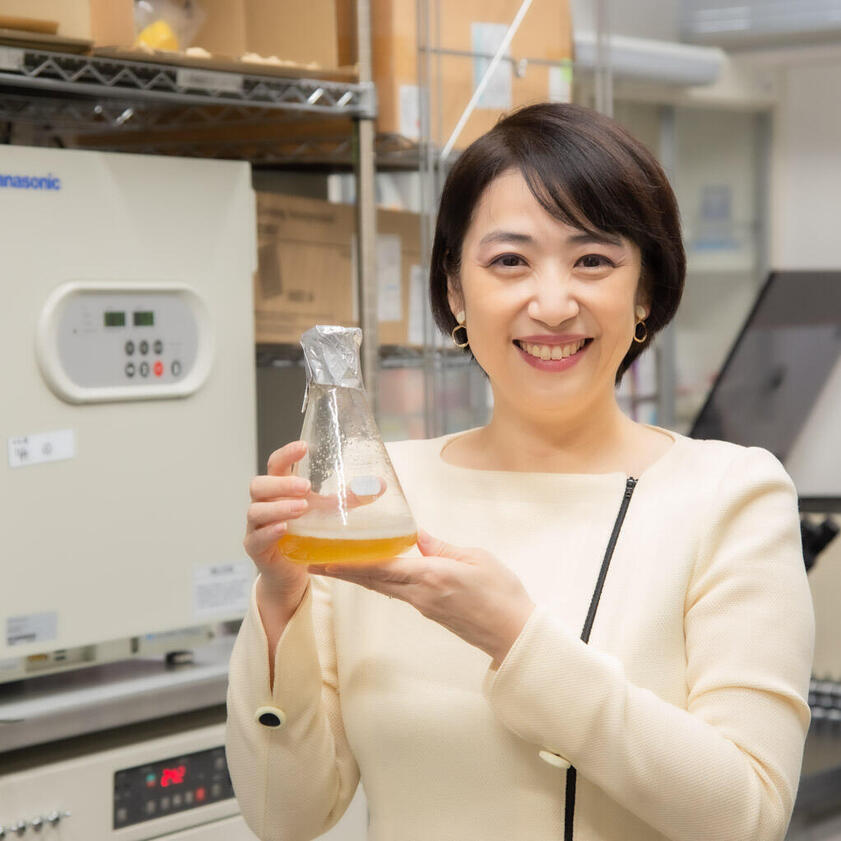Professor Ryuichiro Higashinaka

Researchers'
Associate Professor
Narie Sasaki
Graduate School of Science
I always try to be myself in my life. Even in research, originality, or being oneself, is very important. Just like a work of art, I hope that people can recognize my research in conference presentations or papers, even if my name is not mentioned. I would also like to create an environment that values various personalities and sensitivities so that the people around me can also be themselves.
I am studying the maintenance and transmission of DNA in mitochondria, which produce energy in cells. Since mitochondrial DNA contains genes involved in energy production, it should be precisely replicated and transmitted into the daughter cells through the cell cycle. In addition, mitochondrial DNA is only inherited from mother to offspring, called maternal inheritance. I am investigating the molecular mechanisms of maintenance and inheritance of mitochondrial DNA using the true slime mold, whose mitochondrial DNA is easily observed, and confirming the universality of molecular mechanisms by applying them to human cells.
In the winter of my first year of high school, I read a book called "The Story of Genes," and learned that the blueprint for complex life phenomena (DNA) is made up of only four types of ATGC bases. I was fascinated by the simple beauty thereof and I wanted to find out something about it myself. Then, I told my homeroom teacher that I wanted to be a biological researcher, and he changed my class from humanities to science.
When I find the cleverness in life phenomena, which I had never imagined, through my ingenuity, I can feel the adrenaline flowing through my body. In addition, the growth of my students is one of the great joys that only university teaching can bring.
I have female researcher role models that I admire. Meeting these people and having an environment where I can consult with them at any time is a great asset for me. In Japan, many female students put the brakes on themselves because of vague anxiety. However, at the camp for female students and female faculty members held at the Leading Graduate School, I saw female students grow stronger by seeing closely the female faculty members who were enjoying their research while developing their careers. There are still very few female researchers, but I encourage everyone to look for role models for themselves. It is also very important to choose a husband, so be careful (laughs).
On weekdays, my husband cooks breakfast and lunch, and our supporters (See the photo below) cook dinner. Therefore, for building of my daughter’s memory about her mother’s cooking, I try to cook a meal at least once a weekend. My daughter says that even if the same yakisoba (fried noodles) is made, the taste is completely different depending on who makes it.
When we set up a childcare center for schoolchildren on campus, the preliminary questionnaire showed that more than 20 students who wanted to use the center. However, before the opening the center, the number of students decreased significantly to five and it became clear that we would have to operate at a loss. I became desperate, thinking that we would not be able to find a management company. In that time, my mother told me, "I don’t remember raising a daughter who could not overcome such a problem," and I pulled myself together. At the information session to the companies, I expressed my passion, saying, "I want you to create Japan's first new future with Nagoya University!" I was overjoyed when I received applications from two operators.
Maternal inheritance of mitochondrial DNA is a phenomenon that makes it easy to recognize gender differences, but I recently learned that research and technological development in various fields are being conducted with little data on the female side. In other countries, policies related to gendered innovations that actively incorporate gender perspectives into research and technological development are in progress. I would like to work to ensure that Japan does not lag behind in this field as well as in the advancement of female researchers.
Name: Narie Sasaki
Affiliation: Graduate School of Science
Title: Associate Professor
Career history and hobbies:
Born in Fukui Prefecture, Japan, Dr. Sasaki graduated from the Faculty of Science, Ochanomizu University in 1993, and completed her doctorate at the Graduate School of Science, University of Tokyo in 1998. After working as a postdoctoral fellow, she became an assistant professor in the Faculty of Science at Ochanomizu University and a specially-appointed lecturer in the Graduate School of Humanities and Sciences. She came to Nagoya University with her husband, and after working as a designated associate professor in the Office for Gender Equality, assumed her current position in 2010. From 2019, she is also an Associate Professor at Ochanomizu University (cross appointment), where she also serves as Assistant to the President.
Her hobbies include history (learning about Syungaku Matsudaira and Sanai Hashimoto, who are great men of history).